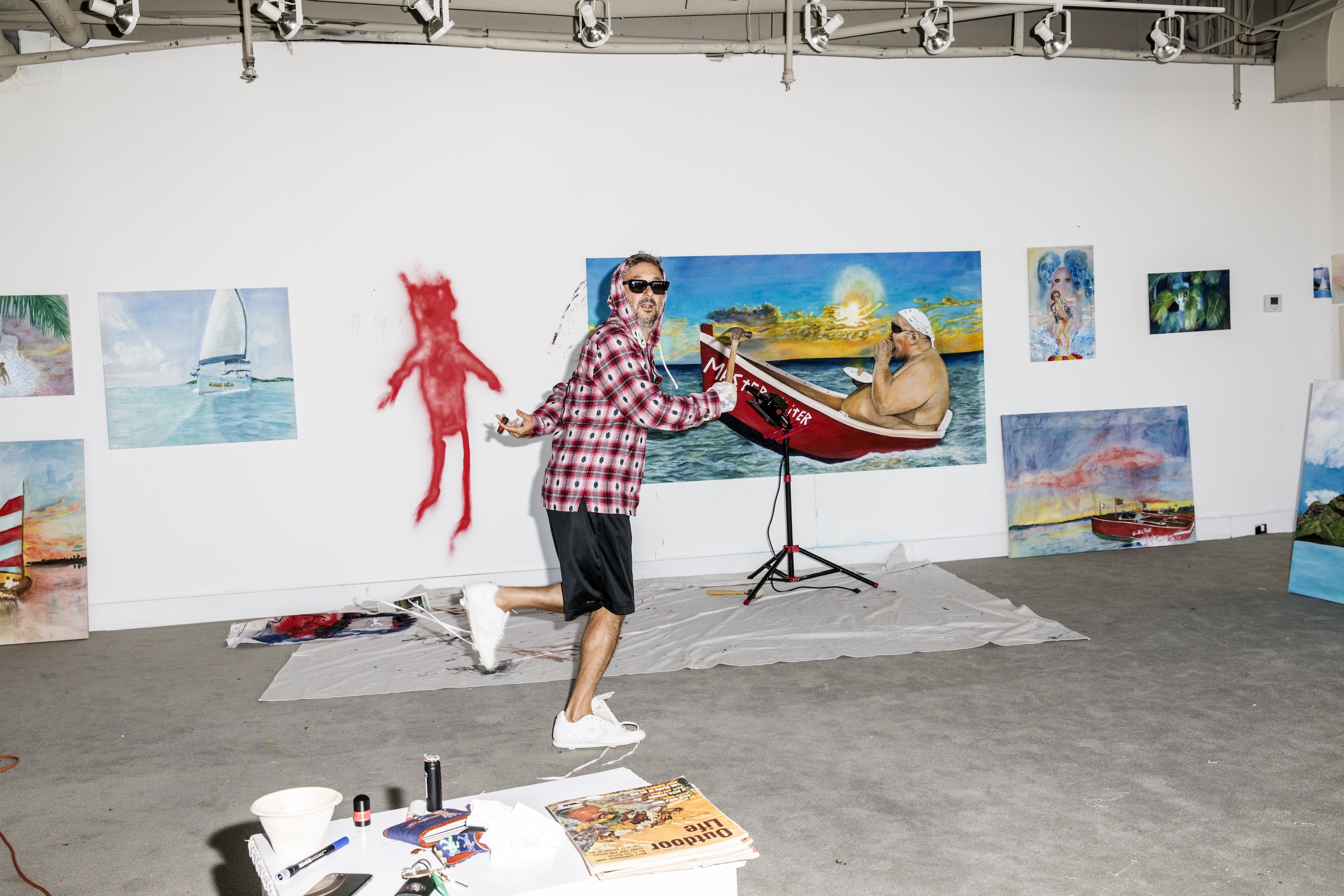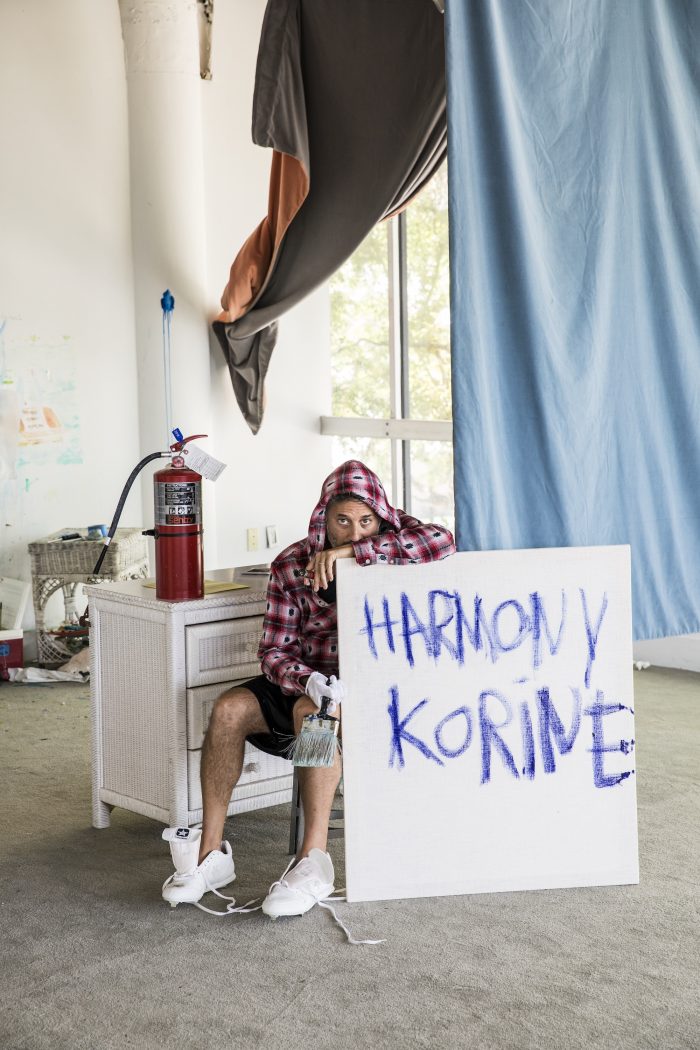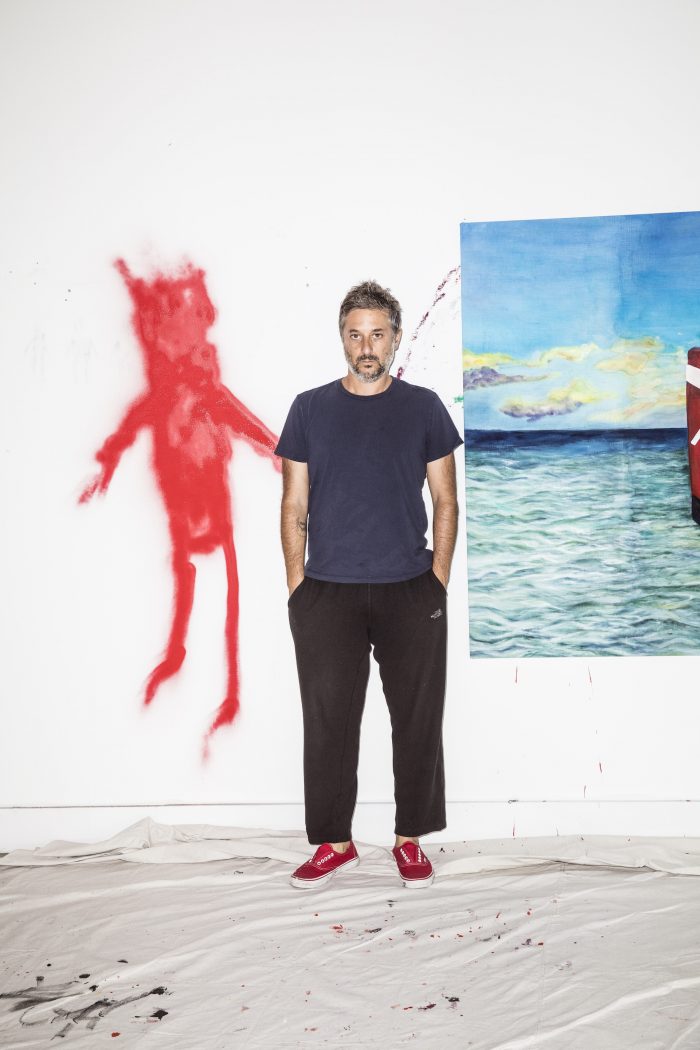
In the year before he and his wife and daughter were forced to evacuate their new waterside home for Hurricane Irma, chances are you could find Harmony Korine in a light-filled lingerie shop-turned-art studio perched above some B-side boutiques in Miami’s Design District, puffing on a Cuban cigar and painting “douche boats.”
“There’s so many douchebags here with boats,” explains Korine, who had just returned to Miami from his hometown of Nashville, where he and his family took refuge during the storm. He got inspired to make the watercolor-on-linen works after seeing Georgia O’Keeffe’s Southwestern landscapes in the medium at her namesake museum in Santa Fe two years ago. “Making artwork in Florida has such a different context to Nashville, so instead of shying away from it I kind of wanted to dive into it and do a whole series of these yachts, with funny pornographic titles like Malcolm XXX, Doggie Style Day Afternoon, Schindler’s Fist, The Bone Ranger or Ocean’s 11 1⁄2 Inches.” Dubbed Adult Yachting, the new paintings will form the basis for his fourth solo show in as many years with Gagosian Gallery in 2018.
“I love the boats. I got Malcolm XXX for myself and a good friend of mine just bought Rambone,” says Larry Gagosian. “They’re kind of a departure, but kind of not. Harmony is just thumbing his nose at nautical art and it’s a nice sidebar. He doesn’t want to go dark right now and he makes a good point. That’s why Jerry Lewis was so popular in Paris. Harmony has an interesting head; you never know what’s coming next.”
The same might be said of Korine’s fortunes of late: his neon-soaked Daytona Beach crime drama Spring Breakers (2012) was acquired by MoMA last year, and this fall he was the subject of a mid-career retrospective, his largest museum show to date, at the Centre Pompidou in Paris. The show featured paintings, journals, films, photos and scripts dating back to his junior-high years and a special room given over to Korine’s more freelance activities—shooting out TVs; spreading rumors around Hollywood; pulling pranks that got him banned from old haunts like the Late Show with David Letterman.
“Harmony has always been a DJ, trying everything in a very free way, making mistakes, moving towards new horizons or dead ends,” says Alicia Knock, the curator who organized the Pompidou exhibition. “Harmony’s work is strong because it translates a certain type of American vernacular, but it is also so obsessively personal that it defies both history and reality. He is very close to postmodern artists and underground culture but remains an outsider who fights authority, morality and norms in a non-ideological, I would say poetic, way.”

For Gagosian, the show was an eye-opener. In the past he had dealt mainly with Korine’s geometric abstraction because, he says, “I could put it into a vocabulary of abstraction that comes out of minimalism, so I felt more comfortable talking about that and representing it. Some of the figurative work can be messy and aggressive and harsh, and I didn’t like it as much, to be frank, but when I saw this show my whole thing flipped. My respect for him as an artist doubled because I connected the dots and I understood where the paintings were coming from.” The opening was filled with teens and twenty- somethings running up to Korine to take selfies, says Gagosian, adding, “He’s like a super smart kid, and a lot of kids try to do what Harmony does but just don’t have the gift. He’s extremely improvisational, he’s profane, but with Harmony it doesn’t come off as forced or like he’s pandering in any way. It just seems like this is the way he’s wired, and this is the way he sees the world.”
“I don’t do any type of self-analyzing, I just make work the way I feel at the time,” says Korine, now 43. He burst onto the scene a quarter-century ago when Larry Clark asked him to write Kids, a gig the young skateboarder scored after handing Clark a script in Washington Square Park about a prostitute. “You can look back and see there’s a corresponding relationship, a mirror to my emotional state. In my younger years I was damn near psychotic and definitely criminal, so the work reflects that.” Though he was born in Bolinas, California and spent his pre–grade school years in hippie communes from Northern California to North Africa, Korine molded his aesthetic sensibilities in the Nashville skate scene before moving to the basement of his grandmother’s apartment in Queens. There, while attending New York University, he wrote Kids and made an art form out of absurdist answering machine messages.
“When I lived in New York I got burned out doing too much, and because I was young and my mind was just flooded with thoughts and imagery and sounds, I was just in this race to get it out. It fucked me up as a person,” says Korine, who returned to Music City 15 years ago, after hitting rock bottom on a brief European odyssey in the wake of a second of three house fires. (His home in Nashville caught fire earlier this year, while he and his wife and daughter were settling into Miami life.) Though he was preparing for the birth of his second child as this issue went to print, he admits, “I know myself now but I do like the trouble. If there’s a shootout somewhere, I still want to run to the action even though I know I should run the other way.”

Korine has been doing just that with some help from his wife, Rachel, an actress he met shortly after returning to his hometown. The growth in his film and artwork during that time has been tremendous—to say nothing of the commercial and video collaborations with everyone from Rihanna to Raf Simons. His career went into serious overdrive following the success of Spring Breakers, which starred James Franco as a gun-toting rapper leading a cadre of killer co-eds (Vanessa Hudgens, Selena Gomez, Ashley Benson and his wife) and grossed more than six times its $5 million budget. It also led to a hypnotic suite of acrylic op-art paintings that he began in abandoned houses around Nashville’s projects (and continued in a massive 50,000-square-foot studio, which he still keeps, carved out of the old Bill Voorhees air-conditioning company building in the city’s Gulch neighborhood). If the abstract works mirror the physicality and trippiness of that film, his haunting figurative works depicting abstracted ghosts, which he’s been making since he was a teenager, channel the dark underworld types of films past like Trash Humpers, Mister Lonely, Julien Donkey-Boy or his beloved directorial debut Gummo.
“This series with the boats is a little different. They’re more narrative, more joke-oriented. It’s not trying to be political or didactic. It’s just checking out, saying, ‘Fuck it all, I’m gonna just drink beer and stare at the ocean,’” says Korine of his new Turner-meets-Tala Madani satires. “I always like playing with the culture; it’s just ingrained in me. When the world is this way, I try to move that way. I’ll still continue to make super dark, violent films and artwork, but at the moment there’s already so much of that. I felt the need to laugh, to try to make something that would crack me up.”
That contrarian worldview has even trickled into Korine’s recent filmmaking decisions. After his last project, The Trap, a “hyper-violent, hyper-stylized revenge drama” about a yacht-robbing crew in Miami fell through at the last moment due to scheduling conflicts after two years of work—“I storyboarded the whole film, I had like 1,500 pages, the movie is done on paper,” says Korine—he switched gears and started writing a comedy called The Beach Bum. Starring Snoop Dogg and Martin Lawrence, the movie revolves around Matthew McConaughey as the title character, Moondog, a once-famous poet who blew up his career for wine, women and song in the Florida Keys.
“I’d always wanted to make a movie about a beach bum, just dudes who live under the piers or in houseboats and drink—guys that just fish and blow shit up,” says Korine. “It’s like a Jimmy Buffet song that’s gone bad, like a tropical Cheech and Chong.”
Though Korine’s mid-century home survived Irma fairly unscathed, aside from a minor “landscape apocalypse” tossing some trees and fences into the pool, the hurricane’s devastation to the Keys put a serious dent in his production schedule. “We were going to shoot all up and down the Keys before the hurricane, but it’s a comedy and you don’t want to make a comedy in a disaster zone. Now we’re gonna focus on Key West, which still looks pretty good,” says Korine, who just returned from a South Florida location-scouting odyssey and is planning to shoot the movie in a sequence of micro scenes over the next two months. “I have a couple hundred locations—a lot of houseboats and strange bars and whore houses—so it’s like putting puzzles together. It won’t have the neon assault of Spring Breakers, but it will have touches of that. It will be pretty beautiful, I think.”
The validation of his films—be it from his early champion and sometime-actor Werner Herzog, Larry Gagosian or curators at MoMA and the Pompidou—is just desserts, but Korine’s ability to adapt at a moment’s notice, and not put out too much work, may be his biggest asset.
“I’ve only made five or six movies. I really don’t like working all the time. I want to have a life and I shy away from that idea of just constantly turning out films and art shows,” argues Korine. “I’m always suspicious of directors and artists who are putting things out one after the other, always looking 10 projects ahead. I never felt comfortable doing that. I barely understand the way that I feel right now, so how can I commit to something two or three years out?”
This revelation brings to mind a particular lament that Korine relayed to me a couple years ago when he was just starting to work on The Trap. “I feel like I’ve never actually gotten to do the things that I really want to do, never in any of the movies. I’ve touched on them, but I’ve never really gotten to do what I’ve wanted to do,” he told me. So what exactly is Harmony Korine looking to do next, I asked? “I want to do serious damage… in the best sense of the word.”










 in your life?
in your life?

